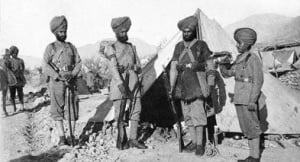Template:Today's featured article: Difference between revisions
Hari singh (talk | contribs) |
Hari singh (talk | contribs) |
||
| Line 1: | Line 1: | ||
==[[ | ==[[Battle of Saragarhi]]== | ||
[[ | '''On September 12, the [[Sikhs]] will remember with honor the supreme sacrifice of their 21 comrades who for the security and safeguard of their country and fellow citizens willing laid down their lives. These soldiers were inspired by the heart piercing message of their tenth Guru, [[Guru Gobind Singh]]''' | ||
''' | *'''Dehi Shiva Bar Mohe Ihe (O God Shiva, give me these boons)''' | ||
*'''Shubh Karman Se Kabhun Na Taron (Never shall I desist from doing good deeds)''' | |||
*'''Na Daron Ari Son Jab Jai Laron (Never shall I fear when I fight the enemy)''' | |||
*'''Nischey Kar Apni Jeet Karon (And with certainty I shall attain victory)''' | |||
[[Image:Sss36thsikhs1896.jpg|thumb|300px|left|The 36th Sikhs is notable for one action that occurred in 1897 when the regiment defended the Samana Ridge against a huge army of Pathans.]] | |||
Saragarhi is the incredible story of 21 men of the 36th Sikh Regiment (currently the 4th Sikh Regiment) who on this day in 1897 gave up their lives in devotion to their duty. In keeping with the tradition of the Indian Army, they fought to the death rather than surrender. The Battle at Saragarhi is one of eight stories of collective bravery published by UNESCO (United Nations Educational, Scientific and Cultural Organization). It has been mentioned as one of the five most significant events of its kind in the world which includes the Saga of Thermoplyae associated with the heroic stand of a small Greek force against the mighty Persian Army of Xerxes in 480 B.C. | |||
== The Background == | |||
The British colonial rulers had constructed a series of forts to control the NWFP (North West Frontier Province - today a state in Pakistan) and to provide security to troops against marauding tribesmen and their lashkars (large body of troops). Most of these forts had initially been built by [[Maharaja Ranjit Singh]] as part of the consolidation of the Sikh empire in Punjab and the British added some more. The British had only partially succeeded in gaining control over this region, consequently, skirmishes and sometimes serious fights with the tribals were a frequent occurrence. However, the NWFP was a good training ground for the Indian Army to hone its skills and techniques. | |||
'''[[Battle of Saragarhi|....Continued]]''' | |||
'''[[ | |||
Revision as of 20:39, 1 August 2005
Battle of Saragarhi
On September 12, the Sikhs will remember with honor the supreme sacrifice of their 21 comrades who for the security and safeguard of their country and fellow citizens willing laid down their lives. These soldiers were inspired by the heart piercing message of their tenth Guru, Guru Gobind Singh
- Dehi Shiva Bar Mohe Ihe (O God Shiva, give me these boons)
- Shubh Karman Se Kabhun Na Taron (Never shall I desist from doing good deeds)
- Na Daron Ari Son Jab Jai Laron (Never shall I fear when I fight the enemy)
- Nischey Kar Apni Jeet Karon (And with certainty I shall attain victory)
Saragarhi is the incredible story of 21 men of the 36th Sikh Regiment (currently the 4th Sikh Regiment) who on this day in 1897 gave up their lives in devotion to their duty. In keeping with the tradition of the Indian Army, they fought to the death rather than surrender. The Battle at Saragarhi is one of eight stories of collective bravery published by UNESCO (United Nations Educational, Scientific and Cultural Organization). It has been mentioned as one of the five most significant events of its kind in the world which includes the Saga of Thermoplyae associated with the heroic stand of a small Greek force against the mighty Persian Army of Xerxes in 480 B.C.
The Background
The British colonial rulers had constructed a series of forts to control the NWFP (North West Frontier Province - today a state in Pakistan) and to provide security to troops against marauding tribesmen and their lashkars (large body of troops). Most of these forts had initially been built by Maharaja Ranjit Singh as part of the consolidation of the Sikh empire in Punjab and the British added some more. The British had only partially succeeded in gaining control over this region, consequently, skirmishes and sometimes serious fights with the tribals were a frequent occurrence. However, the NWFP was a good training ground for the Indian Army to hone its skills and techniques.

